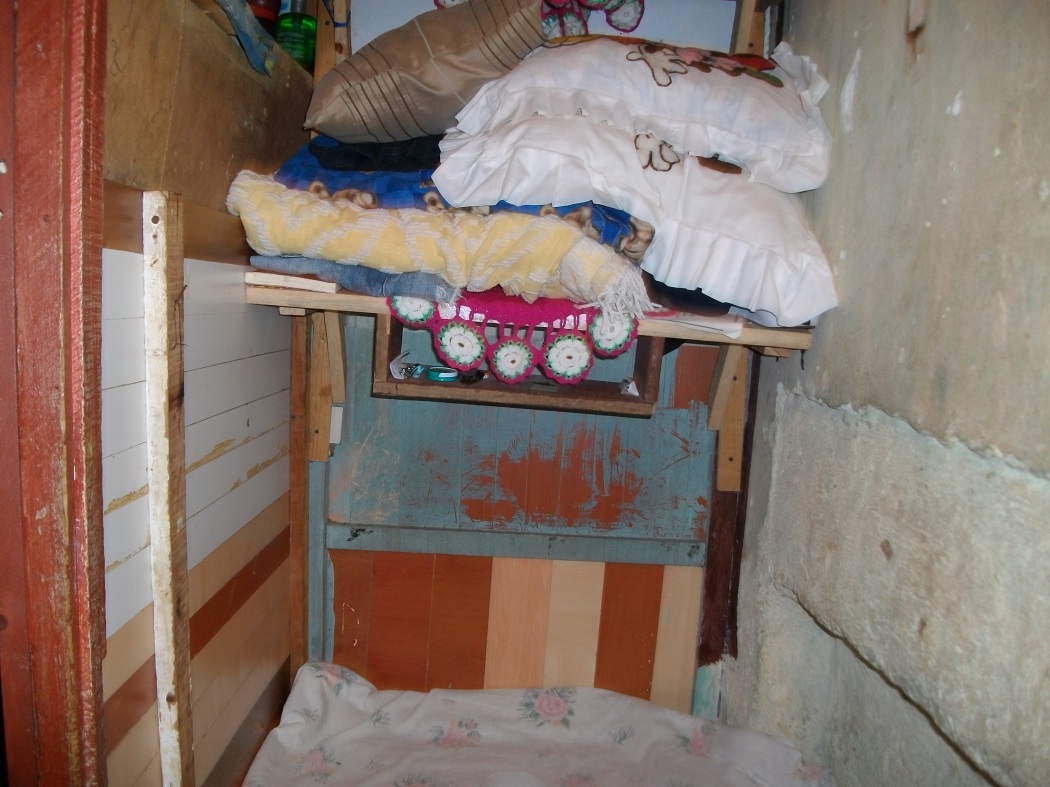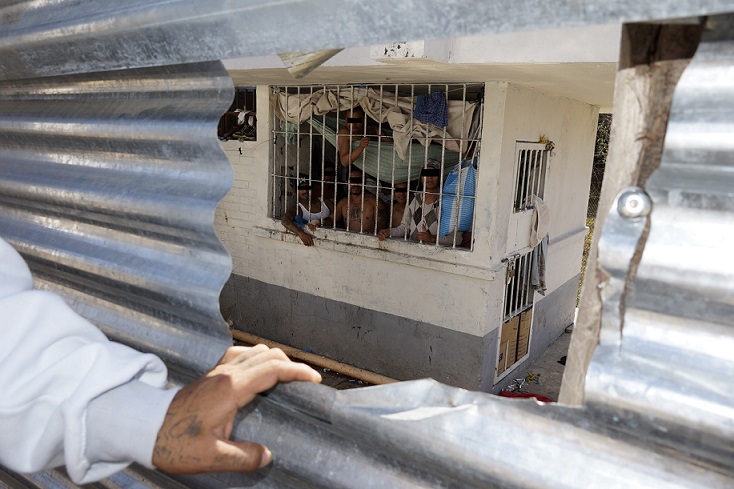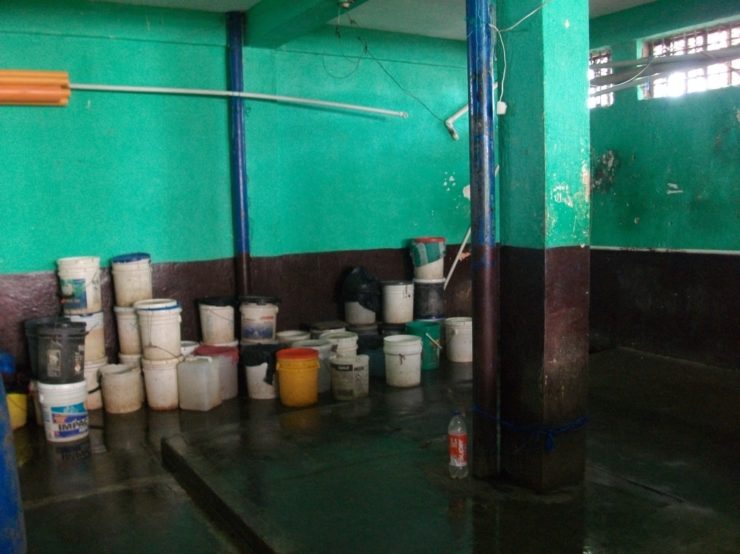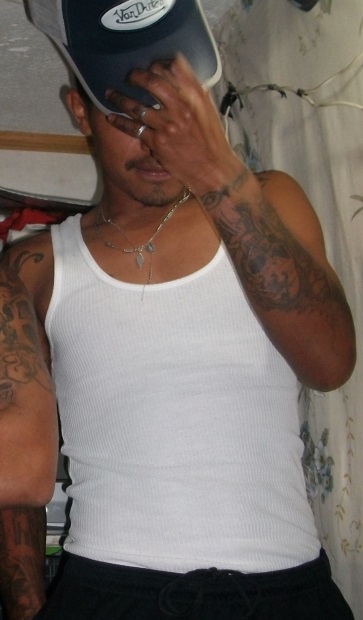Blog
“Here anyone could die…”: Prisons and Human Rights in Guatemala
The Guatemalan prison system collapsed and was abandoned by the Guatemalan state decades ago, according to experts and human rights activists. Currently the penal centers are facing a 300% overpopulation[1] and use additional police jails and military installations to accommodate inmates. In addition, prisons lack (adequate) medical care, alimentation and sleeping arrangements and have become places for sophisticated criminal activities to take place.
In one Guatemalan minimum security prison, Mateo sleeps together with dozens of other inmates on the plain cement floor of a hallway. Rats, mice, numerous insects ceaselessly crawl around him while other inmates step over him, poking him. Endless and sleepless nights he spends on this floor, without rest, trapped between the smell of urine and sweat. Right before the morning count at 5 am, he folds his blanket and puts it carefully to the side, well organized together with the rest of his belongings: love letters from his wife, pictures of his two daughters, a plastic bucket to collect water, an old fashioned enameled plate and a fork, a toothbrush, some soap, one spare jumper and one trouser, two boxer shorts and 2 T-shirts. He then queues to collect water in his plastic bucket, together with the almost 350 people in his sector, in order to shower and wash his few belongings in the courtyard.
Mateo is a gang member of a notorious street gang in Guatemala, serving 30 years for assassination. As a first generation gang member, one of the “veterans,” he is already mid thirty and rich in experiences of gang violence, prison life and state “control”[2]. He was recently transferred from a maximum security installation to the minimum security one, where I am conducting my research.
For over four years, I have been a recurrent visitor of this Guatemalan prison. The prison is a so-called Granja de Modelo de Rehabilitación, a minimum security installation. Part of the inmates serve short sentences (3-6 years) for pickpocketing, illicit gun possession or involuntary manslaughter due to traffic accidents; others serve longer (up to 1.000 years) for extortion, rape, armed robbery, homicide, femicide, assassination or organized crime. The logic of who is eligible for minimum security installations and who has to be placed under maximum security seems arbitrary. Over the course of my research I have become friends and acquaintances with several inmates coming from all kinds of backgrounds and serving all kinds of sentences, and in the process I have learned about countless abuses, pains, restrictions and control they undergo on a daily basis.
According to a 2015 report by the national Human Rights Ombudsman[3], the penitentiary system was assigned 300.700.000 Quetzales (~36.650.000 Euros) in both 2013 and 2014 to finance the construction, equipment and extension of detention centers. In both years, however, zero per cent of this money was reportedly spent on these matters. An additional twenty million Quetzales (~2.430.000 Euros) were assigned to create better infrastructure for inmates, but, likewise, zero percent was in fact used, or reported as having been used.
Not only inmates suffered from the misallocation of money. Penitentiary employees (such as psychologists, social workers, lawyers) also complained to me about their horrendous contracts, obliging them to work at a number of installations at the same time. On occasion, they were not paid for several months. Corinne Dedik, expert on the penitentiary system in Guatemala who works at a think tank called CIEN, additionally confirmed in an interview in July 2016 that some prisons in Guatemala have been without directors for over a year, because of a lack of proper housekeeping. That said, prison guards take over the role of director in turns, for one week each, and then return to their original post. Whether they are acting as a guard or a director; they still earn the same (minimum wage) salaries.
This planned or corrupted underfinancing of the Penitentiary System[4] and its installations not only led to a lack of state control, in terms of overcrowding, underpayment of guards and lack of directory, as discussed above, but additionally encouraged low level corruption. Mateo explains the issue of corruption and the flow of illicit objects the following way:
They [the guards] arrive already here with the mentality to make money (…) even the women who are [working for] the [penitentiary] system. We work with them: the secretaries, the warden, everyone who comes. (…) You know, it’s better for them to befriend the inmates, because it’s more profitable. If they are friends with us, they can have anything. (…) There are some officials, who were my friends at the pre-trial detention, they were surprised to see me here. But they immediately said: ‘Let us know if you need anything’.
This corruption described by Mateo is a very central aspect of the Penitentiary System. We have seen large numbers of “unused” or unreported housekeeping funds above. But corruption by penitentiary workers in installations also means a direct flow of illicit objects and commodities through obvious porous prison frontiers. The easy access to these illicit objects (very often firearms or machetes), frequently results in direct violent outbreaks.
Hence, Guatemalan prisons are often referred to as “chaotic” and out of order. During my research, however, I have realized that prisons are far from disorganized or chaotic spaces of confinement. Rather, they are inmate-governed and ruled by strict regulations and order imposed by an inmate committee and an ‘elected’ inmate spokesman. This shows that the state has lost its control over the installations and is far from being able to protect inmate rights or needs. The Minister of Interior himself said in an interview with Prensa Libre (a national daily newspaper) on June 11, 2016[5], that the state has no database on the exact numbers and identities of inmates.
The disorganization is mostly related to state authority, however, while inmates use this lack of power to become their own masters; they archive inmate transfers and private information of fellow inmates, organize work schedules, run private-owned companies within prison, exploit and extort fellow prison workers, and decide over rules, laws and potential “suicides” (extra-judicial killings) to enforce fear and “respect”. For example, committees and spokesmen charge “talachas” (free translation: extortions) which new inmates have to pay upon arrival at the facility and serve to cover the expenses of cleaning, housing, and luxury lifestyles of powerful inmates. In case these extortions cannot be paid, new arrivals have to perform forced labor, doing such tasks as renovating buildings, organizing waste or cleaning sewer systems without the necessary equipment. Upon the new arrival of an inmate the committee or spokesmen “do something like an interview with you”, Mateo explains, in which they ask:
“if someone can pay the money, how much you have, if you have family, how much time you are serving. There they have your data sheet, your behavior(…). You have to pay 2500 Quetzales (~305 Euros) only to enter here, and another 2500 you have to pay in your sector so that they give you a space, but since I don’t have a space, I hang out in ‘the street’ [meaning prison courtyards, hallways and prison outdoors] with my homies.”

Privileged space for an inmate who was able to obtain his private space, away from the hallway floor. Wealthier inmates can also have their own rooms or apartments.
Mateo explains to me that the talachas they are forced to pay is one reason why inmates usually do not want to be transferred to other installations:
“also entering other prisons they always ask you for money (…). This is why people do not want to [be] always transferred. In another place they might be there already for years, and there they are already installed, they have somewhere to sleep, maybe even have work there.”
Illicit inmate networks seem to document their fellow inmates on a more accurate level than the state is capable of. But in the end Mateo adds:
“We never really know if someone is missing, the numbers during counting are always right, also if someone overslept and was not there for the count. So, you know, in theory it couldn’t be right. But that’s how life here is like.”

La casita is a place where inmates who committed a crime within prison are brought to in order to be punished. Sometimes up to 40 people can be “incarcerated” in 2 3×5 m cells, where they are forced to sleep in turns because of lacking space.
So far, I have tried to give you an idea of the current situation in Guatemalan prisons. In the following, I would like to address two types of deaths that could occur to any inmate within these installations. First, I will address violent deaths, and second, ‘natural’ deaths.
In 2015 it was nine times more probable to die inside a Guatemalan prison than in Guatemala City, a city that has one of the highest rates of violent death worldwide[6]. When I talk with Mateo about fear of violence and everyday life in prison, he expresses his feelings the following way:
(…) Here anyone could die, they just grab anyone, or in any riot. (…) Here it is scarier than in the street. In the street you can save your life: you can run into a house, fight for your life, right. But here… where will you run to? (…) What happens is, that the death in prison is not a normal death. That they value you in some kind of way, right. Here they cut your head off. And the worst deaths that might happen, are to die burned, strangled or decapitated, right? These are the saddest deaths. That your family will know that they cut your head off, right?
If we look at the number of violent deaths in the prison system between July 2015 and July 2016, we can see that 146 deaths have been registered, most of them violent deaths. Clearly, Mateo’s fear of death within prison is not unfounded. I was personally present in the prison, when one day two people ‘hanged themselves’ (or ‘were suicided’ as inmates use to say, killed extra-judicially). One in the morning, one in the evening. And I cannot say for sure if those deaths were actually counted within the 146. In September 2015, gang members in “my” prison were planning to bring a firearm[7] inside and ended up almost being decapitated by the prison spokesman. In December 2015 a riot in Granja Penal Canadá, Escuintla, a center with a capacity of 600 which currently hosts 3.063 inmates, supervised only by 17 active guards, ended up in 17 deaths, various victims of which were decapitated [8].During the first seven months of 2016, 70 violent deaths were registered, of which at least 17 happened in the prison where I conducted my research, and who were shot by firearms, decapitated or burned alive. Most of the deaths occurred during the killing of the former prison king Byron Lima, an ex-military captain who ruled the most elaborate illicit prison network of the whole country.
We have seen earlier that the rights and needs of the single inmate are not protected. The Guatemalan state is incapable of doing so, because they lost their control to illicit prison networks, and the networks themselves, similar to the state, do not care about legal, or medical care for the individual inmate. Thus, prisons are often characterized by inadequate sanitation, with a correspondingly alarming situation of hygiene, leading to all kinds of illnesses and skin infections such as scabies. Rare access to water and no free access to drinking water further exacerbate these problems. A doctor, assigned to the prison of my research, attends his office on arbitrary days and times and does not have accurate medication, nor time to attend the individual inmate’s needs. Inmates themselves have to provide for their medication, as the doctor’s office only occasionally counts on basic supplies such as analgesics, antipyretics and anti-diarrheal.
Once I accompanied a friend of Mateo, Alejandro, who was one of my closer informants and a gang member, to the doctor’s office. He was suffering from a severe stomach ache, was vomiting blood for several weeks (!) and had blood in his feces. If it would not be for me, he assured me, he would not receive any medical attention because he is tattooed. Another informant of mine suffered from tuberculosis and was not allowed to avail of hospital care until he was almost dying in his cell, putting at risk every inmate around him for possible tuberculosis infections. Again another inmate suffered from stomach cancer and carried around an abscess of the size of an orange without any medical care. Until this day, Alejandro has not been treated for his disease, nor does he know what disease he is suffering from. His inmate friends provide him with basic medication to fight the symptoms. He is not allowed to attend medical care at the nearest hospital. Alejandro is only 24 years old.
On November 3, 2016, the Inter-American Court for Human Rights (CIDH) sentenced the Guatemalan State for violations of the right to life and health of people deprived of their liberty in penitentiary centers. This is related to the case of María Inés Chinchilla Sandoval, a female inmate, who was sentenced to 30 years in prison in 1995. María suffered from multiple illnesses, including diabetes mellitus and arterial hypertension. Between 1997 and 2002 she was constantly and systemically denied medication as well as medical attention. Her visits to the hospital were at times not approved by judges on time, and on other occasions the visits were cancelled because of the unavailability of accurate transfer. María died in 2004 after falling down a flight of stairs at the female detention center in her wheelchair[9].
Deaths, in this case, also if they are ‘natural’, could have been prevented on many occasions and are at times even forced by the state neglecting basic rights and medical care to the inmates who fully depend on the state’s protection.
With this blog I wanted to illustrate that prisons are spheres outside of reach for human rights. If states are incapable of providing a safe space or medical care, violent and natural deaths can both be attributed to the state.
[1] Total population 20697 (27.07.2016 number provided by the Penitentiary System) in August 2016, capacity is for only 6.742. http://www.prisonstudies.org/country/guatemala
[2] Many inmates used to regularly change their names in order to have a tabula rasa in their criminal records and, thus, have a possibility to get out of prison for good behavior after serving 50% of their sentence. This is mostly related to the general lack of identification cards of many people from urban poor areas: many lack birth certificates, others never bothered about getting identification cards once they turned 18 (minors only carry birth certificates). This relates, most likely, to their perception of being excluded from citizenship rights. Urban marginal neighborhoods often suffer under structural violence and abandonment from the state in terms of citizen needs such as education, potable water, medical care, infrastructure, etc. and experience the state rather trough politics of repression and violence.
[3] Procurador de los Derechos Humanos. 2015. Contribución del Procurador de los Derechos Humanos de Guatemala a la Oficina del Alto Comisionado para los Derechos Humanos, sobre las Causas y Efectos del Hacinamiento en los Centros de Detención y sus Implicaciones para los Derechos Humanos. April 2015. http://www.ohchr.org/Documents/Issues/RuleOfLaw/OverIncarceration/PDH_Guatemala.pdf
[4] Please also have a look at the current proceses against impunity and organized crime in Guatemala, in which, besides others, ex president Otto Perez Molina (2012-2015), his vize president Roxana Baldetti and more than 35 former government officials are being charged with corruption and currently in pre-trial detention. https://www.hrw.org/world-report/2016/country-chapters/guatemala. For more information please check the website of the International Commission against Impunity in Guatemala. http://www.cicig.org
[5]Prensa Libre. 2016. Gobernación no tiene registro de reos. http://www.prensalibre.com/guatemala/justicia/gobernacion-no-tiene-registro-de-reos
[6] El País. 2016. El Infierno en la s cárceles guatemaltecas. http://internacional.elpais.com/internacional/2016/08/20/america/1471645019_313831.html
[7] http://www.prensalibre.com/guatemala/justicia/ria-entre-reos-de-pavon-deja-20-heridos
[8] Informe anual del Alto Comisionado de las Naciones Unidas para los Derechos Humanos sobre las actividades de su oficina en Guatemala. February 2016 http://www.acnur.org/t3/fileadmin/Documentos/BDL/2016/10308.pdf
[9] ICCPG 2016. Comunicado del Instituto de Estudios Comparados de Ciencias Penales de Guatemala. Corte Interamericana condena al estado de Guatemala por Violaciones al Derecho a la Vida y la Salud de Privados de Libertad en los Centros de Reclusión. Guatemala, 08.11.2016



